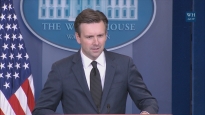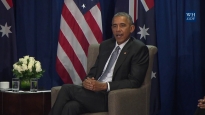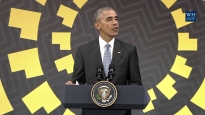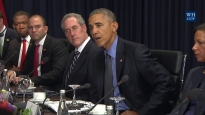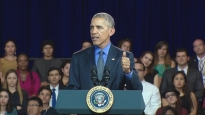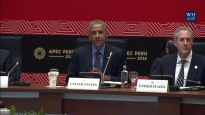20th Anniversary of the Americans with Disabilities Act
July 26, 2010 | 45:31 | Public Domain
President Obama and others speak at an event commemorating the 20th anniversary of the Americans with Disabilities Act.
Remarks by the President on 20th Anniversary of the Americans with Disabilities Act
6:26 P.M. EDT
THE PRESIDENT: Thank you. Good evening, everybody. (Applause.) Thank you so much. Well, we have a gorgeous day to celebrate an extraordinary event in the life of this nation. Welcome, all of you, to our White House. And thank you, Robert, for the wonderful introduction. It is a pleasure and honor to be with all of you on the 20th anniversary of one of the most comprehensive civil rights bills in the history of this country -- the Americans with Disabilities Act. (Applause.)
I see so many champions of this law here today. I wish I had time to acknowledge each and every one of you. I want to thank all of you. But I also want to thank our Cabinet Secretaries and the members of my administration here today who are working to advance the goals of the ADA so that it is not just the letter of the law, but the spirit of the law, that's being applied all across this country. (Applause.)
I want to thank the members of Congress in attendance who fought to make ADA possible and to keep improving it throughout the years. (Applause.) I want to acknowledge Dick Thornburgh, who worked hard to make this happen as Attorney General under President George H.W. Bush. (Applause.)
And by the way, I had a chance to speak to President Bush before I came out here, and he sends heartfelt regards to all of you. And it’s -- he’s extraordinarily proud of the law that was passed. He was very humble about his own role, but I think it’s worth acknowledging the great work that he did. (Applause.)
We also remember those we’ve lost who helped make this law possible -- like our old friend, Ted Kennedy. (Applause.) And I see Patrick here. And Justin Dart, Jr., a man folks call the father of the ADA -- whose wife Yoshiko, is here. (Applause.) Yoshiko, so nice to see you. (Applause.)
I also notice that Elizabeth Dole is here, and I had a chance to speak to Bob Dole, as well, and thank him for the extraordinary role that he played in advancing this legislation. (Applause.)
Let me also say that Congressman Jim Langevin wanted to be here today, but he’s currently presiding over the House chamber -- the first time in our history somebody using a wheelchair has done so. (Applause.)
Today, as we commemorate what the ADA accomplished, we celebrate who the ADA was all about. It was about the young girl in Washington State who just wanted to see a movie at her hometown theater, but was turned away because she had cerebral palsy; or the young man in Indiana who showed up at a worksite, able to do the work, excited for the opportunity, but was turned away and called a cripple because of a minor disability he had already trained himself to work with; or the student in California who was eager and able to attend the college of his dreams, and refused to let the iron grip of polio keep him from the classroom -- each of whom became integral to this cause.
And it was about all of you. You understand these stories because you or someone you loved lived them. And that sparked a movement. It began when Americans no longer saw their own disabilities as a barrier to their success, and set out to tear down the physical and social barriers that were. It grew when you realized you weren’t alone. It became a massive wave of bottom-up change that swept across the country as you refused to accept the world as it was. And when you were told, no, don’t try, you can’the -- you responded with that age-old American creed: Yes, we can. (Applause.)
AUDIENCE MEMBER: (Inaudible.)
THE PRESIDENT: Yes, we can!
Sit-ins in San Francisco. Demonstrations in Denver. Protests in Washington, D.C., at Gallaudet, and before Congress. People marched, and organized, and testified. And laws changed, and minds changed, and progress was won. (Applause.)
Now, that’s not to say it was easy. You didn’t always have folks in Washington to fight on your behalf. And when you did, they weren’t as powerful, as well-connected, as well-funded as the lobbyists who lined up to kill any attempt at change. And at first, you might have thought, what does anyone in Washington know or care about my battle? But what you knew from your own experience is that disability touches us all. If one in six Americans has a disability, then odds are the rest of us love somebody with a disability.
I was telling a story to a group that was in the Oval Office before I came out here about Michelle’s father who had MS. By the time I met him, he had to use two canes just to walk. He was stricken with MS when he was 30 years old, but he never missed a day of work; had to wake up an hour early to get dressed --
AUDIENCE MEMBER: So what.
THE PRESIDENT: -- to get to the job, but that was his attitude -- so what. He could do it. Didn't miss a dance recital. Did not miss a ball game of his son. Everybody has got a story like that somewhere in their family.
And that’s how you rallied an unlikely assortment of leaders in Congress and in the White House to the cause. Congressmen like Steny Hoyer, who knew his wife Judy’s battle with epilepsy; and Tony Coehlo, who waged his own; and Jim Sensenbrenner, whose wife, Cheryl, is a tremendous leader and advocate for the community. And they're both here today. (Applause.)
Senators like Tom Harkin, who’s here today, and who signed -- (applause) -- who signed part of a speech on the ADA so his deaf brother, Frank, would understand. And Ted Kennedy, whose sister had a severe intellectual disability and whose son lost a leg to cancer. And Bob Dole, who was wounded serving heroically in World War II. Senior officials in the White House, and even the President himself.
They understood this injustice from the depths of their own experience. They also understood that by allowing this injustice to stand, we were depriving of our nation -- we were depriving our nation and our economy of the full talents and contributions of tens of millions of Americans with disabilities.
That is how the ADA came to be, when, to his enduring credit, President George H.W. Bush signed it into law, on this lawn, on this day, 20 years ago. That’s how you changed America. (Applause.)
Equal access -- to the classroom, the workplace, and the transportation required to get there. Equal opportunity -- to live full and independent lives the way we choose. Not dependence -- but independence. That’s what the ADA was all about. (Applause.)
But while it was a historic milestone in the journey to equality, it wasn’t the end. There was, and is, more to do. And that’s why today I’m announcing one of the most important updates to the ADA since its original enactment in 1991.
Today, the Department of Justice is publishing two new rules protecting disability-based discrimination -- or prohibiting disability-based discrimination by more than 80,000 state and local government entities, and 7 million private businesses. (Applause.) And beginning 18 months from now, all new buildings must be constructed in a way that’s compliant with the new 2010 standards for the design of doors and windows and elevators and bathrooms -- (applause) -- buildings like stores and restaurants and schools and stadiums and hospitals and hotels and theaters. (Applause.)
My predecessor’s administration proposed these rules six years ago. And in those six years, they’ve been improved upon with more than 4,000 comments from the public. We’ve heard from all sides. And that’s allowed us to do this in a way that makes sense economically and allows appropriate flexibility while ensuring Americans with disabilities full participation in our society.
And for the very first time, these rules will cover recreational facilities like amusement parks and marinas and gyms and golf facilities and swimming pools -- (applause) -- and municipal facilities like courtrooms and prisons. (Applause.) From now on, businesses must follow practices that allow individuals with disabilities an equal chance to purchase tickets for accessible seating at sporting events and concerts. (Applause.)
And our work goes on. Even as we speak, Attorney General Eric Holder is preparing new rules to ensure accessibility of websites. (Applause.)
AUDIENCE: Yes, we can.
THE PRESIDENT: Yes, we can.
We’re also placing a new focus on hiring Americans with disabilities across the federal government. (Applause.) Today, only 5 percent of the federal workforce is made up of Americans with disabilities -- far below the proportion of Americans with disabilities in the general population. In a few moments, I’ll sign an executive order that will establish the federal government as a model employer of individuals with disabilities. (Applause.) So we’re going to boost recruitment, we’re going to boost training, we’re going to boost retention. We’ll better train hiring managers. Each agency will have a senior official who’s accountable for achieving the goals we’ve set. And I expect regular reports. And we’re going to post our progress online so that you can hold us accountable, too. (Applause.)
And these new steps build on the progress my administration has already made.
To see it that no one who signs up to fight for our country is ever excluded from its promise, we’ve made major investments in improving the care and treatment for our wounded warriors. (Applause.) To ensure full access to participation in our democracy and our economy, we’re working to make all government websites accessible to persons with disabilities. (Applause.)
We’re expanding broadband Internet access to Americans who are deaf and hard of hearing. We’ve followed through with a promise I made to create three new disability offices at the State Department and Department of Transportation and at FEMA.
And to promote equal rights across the globe, the United States of America joined 140 other nations in signing the U.N. Convention on the Rights of Persons with Disabilities -- the first new human rights convention of the 21st century. (Applause.)
America was the first nation on Earth to comprehensively declare equality for its citizens with disabilities. We should join the rest of the world to declare it again -- and when I submit our ratification package to Congress, I expect passage to be swift. (Applause.)
And to advance the right to live independently, I launched the Year of Community Living, on the 10th anniversary of the Olmstead decision -- a decision that declared the involuntary institutional isolation of people with disabilities unlawful discrimination under the ADA. (Applause.)
So HHS Secretary Kathleen Sebelius and HUD Secretary Shaun Donovan have worked together to improve access to affordable housing and community supports and independent living arrangements for people with disabilities. And we continued a program that successfully helps people with disabilities transition to the community of their choice. (Applause.) And I’m proud of the work that the Department of Justice is doing to enforce Olmstead across the country.
And we’ve finally broken down one discriminatory barrier that the ADA left in place. Because for too long, our health care system denied coverage to tens of millions of Americans with preexisting conditions -- including Americans with disabilities. It was time to change that. And we did. Yes, we did. (Applause.)
So the Affordable Care Act I signed into law four months ago will give every American more control over their health care -– and it will do more to give Americans with disabilities control over their own lives than any legislation since the ADA. I know many of you know the frustration of fighting with an insurance company. That’s why this law finally shifts the balance of power from them to you and to other consumers. (Applause.)
No more denying coverage to children based on a preexisting condition or disability. No more lifetime limits on coverage. No more dropping your coverage when you get sick and need it the most because your insurance company found an unintentional error in your paperwork. (Applause.) And because Americans with disabilities are living longer and more independently, this law will establish better long-term care choices for Americans with disabilities as a consequence of the CLASS Act, an idea Ted Kennedy championed for years. (Applause.)
Equal access. Equal opportunity. The freedom to make our lives what we will. These aren’t principles that belong to any one group or any one political party. They are common principles. They are American principles. No matter who we are -- young, old, rich, poor, black, white, Latino, Asian, Native American, gay, straight, disabled or not -- these are the principles we cherish as citizens of the United States of America. (Applause.)
They were guaranteed to us in our founding documents. One of the signers of those documents was a man named Stephen Hopkins. He was a patriot, a scholar, a nine-time governor of Rhode Island. It’s also said he had a form of palsy. And on July 4, 1776, as he grasped his pen to sign his name to the Declaration of Independence, he said, “My hand trembles. But my heart does not.” My hand trembles. But my heart does not.
Life, liberty, the pursuit of happiness. Words that began our never-ending journey to form a more perfect union. To look out for one another. To advance opportunity and prosperity for all of our people. To constantly expand the meaning of life, liberty, the pursuit of happiness. To move America forward. That’s what we did with the ADA. That is what we do today. And that’s what we’re going to do tomorrow -- together.
So, thank you. God bless you. And God bless the United States of America. Let me sign this order. (Applause.)
END 6:44 P.M. EDT
|
November 22, 2016
|
November 22, 2016
|
November 20, 2016
|
November 20, 2016
|
|
November 20, 2016
|
November 19, 2016
|
November 19, 2016
|
November 19, 2016
|
- &lsaquo previous
- …
- 6
- 7
- 8
- 9
- 10
- 11
- 12
- 13
- 14
- …
- next &rsaquo

